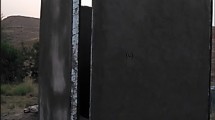Abstract
In the framework of the international benchmark “Vulcain tests on 3 Walls”, three full scale ISO fire tests on a reinforced concrete wall, simultaneously subjected to a constant uniaxial compressive load, were conducted in CSTB in Paris, France. The duration of these tests exceeded 120 min. In order to assess the capability of available finite elements (FE) models to represent reinforced concrete structural behaviour under fire exposure, IRSN, within the scope of the Vulcain benchmark, set up a modelling with help of Mazars isotropic continuum damage mechanical model (Mazars Application de la mécanique de l’endommagement au comportement non linéaire et à la rupture du béton de structure. PhD Thesis, Univ. Paris 6, ENS Cachan, France, 1984) ran with the CAST3M software (Verpeaux et al. in Fouet, Ladevèze and Ohayon (eds), Calcul des Structures et Intelligence Artificielle, Pluralis, 1988), while a user-defined procedure was used to calculate the concrete properties taking into account load induced thermal strains (LITS). The effect of LITS according to the model of Anderberg and Thelandersson (Stress and deformation characteristics of concrete at high temperatures: 2 experimental investigation and material behavior model, Bulletin 54, Lund Institute of Technology, Lund, 1976) was considered by an explicit term in the strain decomposition. Also, the numerical simulation of three full scale ISO fire tests of Vulcain was carried out with the help of a FE model that takes into account the values of the concrete thermomechanical parameters identified. The numerical model is composed of two different parts, one for heat transfer analysis and the other one for structural analysis based on a three-dimensional FE model including concrete and reinforcing steel meshes. It is illustrated through this numerical investigation that the proposed model can predict the thermomechanical behaviour of reinforced concrete walls under fire exposure.















Similar content being viewed by others
References
Mazars J (1984) Application de la mécanique de l’endommagement au comportement non linéaire et à la rupture du béton de structure. PhD Thesis, Univ. Paris 6, ENS Cachan, France
Verpeaux P, Charras T, Millard A (1988) CASTEM 2000: une approche moderne du calcul des structures. In: Fouet JM, Ladevèze P, Ohayon R (eds) Calcul des Structures et Intelligence Artificielle. Pluralis, pp 261–271
Anderberg Y, Thelandersson S (1976) Stress and deformation characteristics of concrete at high temperatures: 2 experimental investigation and material behavior model. Bulletin 54, Lund Institute of Technology, Lund
Miah M J, Pinoteau N, Pimienta P (2016) A thermomechanical experimental investigation on 3 loaded concrete walls exposed to ISO 834-1 fire. In: 9th international conference on structures in fire, Princeton, USA
Mindeguia JC (2009) Contribution expérimental a la Compréhension des risqué d’instabilité thermiques des bétons. PhD Thesis, Université de Pau et des Pays de l’Adour, France
CEN, EN 1992-1-2 (2005) Eurocode 2: design of concrete structures, Part 1–2: General rules—structural fire design. European Committee for Standardisation
Kachanov M (1959) Effective elastic properties of cracked solid: critical review of some basic concepts. Appl Mech Rev 45:304–335
Roosefid M (2006) Etude du Comportement Thermomécanique de deux Bétons Réfractaires silico-alumineux: applications à une poche d’aciérie. PhD Thesis, Institut National Polytechnique de Grenoble, France
La Borderie C (2003) Stratégies et modèles de calculs pour les structures en béton. HDR Thesis, Université de Pau et des pays de l'Adour, France
Bazant ZP, Oh BH (1983) Crack band theory for fracture of concrete. Mater Struct 16:155–177
De Sa C (2007) Etude hydro-mécanique et thermo-mécanique du béton: influence des gradients et des incompatibilités de deformation. PhD Thesis, ENS Cachan, France
Gernay T, Franssen J-M (2015) A plastic-damage model for concrete in fire: Applications in structural fire engineering. Fire Saf J 71:268–278
Gernay T, Franssen J-M (2012) A formulation of the Eurocode 2 concrete model at elevated temperature that includes an explicit term for transient creep. Fire Saf J 51:1–9
Youssef MA, Moftah M (2007) General stress–strain relationship for concrete at elevated temperatures. Eng Struct 29:2618–2634
Gernay T (2012) A multiaxial constitutive model for concrete in the fire situation including transient creep and cooling down phases. PhD Thesis, University of Liège, Belgium
CEN, EN 1991-1-2 (2003) Eurocode 1: actions on structures, part 1–2: general actions—actions on structures exposed to fire. European Committee for Standardisation
Author information
Authors and Affiliations
Corresponding author
Ethics declarations
Conflict of interest
The authors declare that they have no known competing financial interests or personal relationships that could have appeared to influence the work reported in this paper.
Additional information
Publisher's Note
Springer Nature remains neutral with regard to jurisdictional claims in published maps and institutional affiliations.
Rights and permissions
Springer Nature or its licensor (e.g. a society or other partner) holds exclusive rights to this article under a publishing agreement with the author(s) or other rightsholder(s); author self-archiving of the accepted manuscript version of this article is solely governed by the terms of such publishing agreement and applicable law.
About this article
Cite this article
Roosefid, M., Bonhomme, MH. & Pimienta, P. Contribution to the Modelling of the Structural Behavior of Reinforced Concrete Walls Under ISO Fire Exposure. Fire Technol 59, 3185–3201 (2023). https://doi.org/10.1007/s10694-023-01460-1
Received:
Accepted:
Published:
Issue Date:
DOI: https://doi.org/10.1007/s10694-023-01460-1




